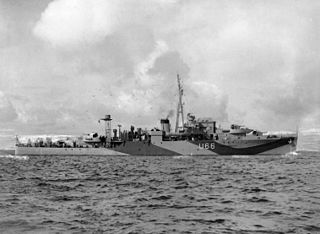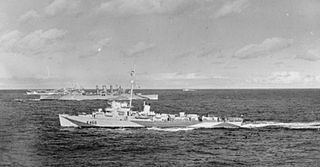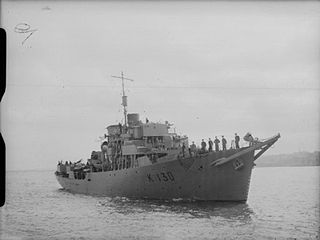Related Research Articles

HMS Starling, pennant number U66, was a Modified Black Swan-class sloop of the Royal Navy. She was active in the Battle of the Atlantic during the Second World War and was the most successful anti-submarine warfare vessel of the Royal Navy, being credited with the destruction of fourteen U-boats.

HMS Arbutus was a Flower-class corvette of the Royal Navy, which was active during the Second World War. She was a successful escort vessel, and took part in the destruction of two U-boats during the Battle of the Atlantic. Arbutus was sunk in the North Atlantic in February 1942.

HMS Bickerton was a Captain-class frigate of the Royal Navy. She served during the World War II as a convoy escort and anti-submarine warfare vessel in the Battle of the Atlantic and was an effective U-boat killer, being credited with the destruction of two U-boats during a service career of just 10 months. Bickerton was lost in action on 22 August 1944.

HMS Conn was a TE ("Buckley") Type Captain class frigate of the Royal Navy. She served during World War II as a convoy escort and anti-submarine warfare vessel in the Battle of the Atlantic and was credited with the destruction of two U-boats during the conflict.

HMS Duckworth (K351) was a Captain-class frigate of the Royal Navy. She served during the Second World War as a convoy escort and anti-submarine warfare vessel in the Battle of the Atlantic and was an effective U-boat killer, being credited with the destruction of five U-boats during the conflict.

HMS Lotus was a Flower-class corvette that served in the Royal Navy.

Convoy SC 130 was a North Atlantic convoy which ran during the battle of the Atlantic in World War II. It was the 130th of the numbered series of Slow Convoys of merchant ships from Sydney, Cape Breton Island to Liverpool. SC 130 was one of several convoy battles that occurred during the crisis month of May 1943.
SC 143 was a North Atlantic convoy of the SC series which ran during the battle of the Atlantic in World War II. It was the second battle in the Kriegsmarine's autumn offensive in the North Atlantic.
ONS 20 and ON 206 were North Atlantic convoys of the ONS/ON series which ran during the battle of the Atlantic in World War II. They were the subject of a major U-boat attack in October 1943, the third battle in the Kriegsmarine's autumn offensive.
HX 228 was a North Atlantic convoy of the HX series which ran during the Battle of the Atlantic in World War II. It was one of a series of four convoy battles that occurred during the crisis month of March 1943 and is notable for the loss of the Escort Group leader Commander AA "Harry" Tait.
ON 207 was a North Atlantic convoy of the ONS/ON series which ran during the Battle of the Atlantic in World War II. It was the subject of a major U-boat attack in October 1943, the fourth battle in the German autumn offensive.
The 2nd Escort Group was a British anti-submarine formation of the Royal Navy which saw action during the Second World War, principally in the Battle of the Atlantic.
Escort Group B7 was a British formation of the Royal Navy which saw action during the Second World War; principally in the Battle of the Atlantic.
36th Escort Group was a British formation of the Royal Navy which saw action during the Second World War, principally in the Battle of the Atlantic. The group operated mainly on the Gibraltar and South Atlantic convoy routes and was involved in several convoy battles, including Convoy HG 76, one of the first Allied victories in the Atlantic campaign.
5th Escort Group was a British formation of the Royal Navy which saw action during the Second World War, principally in the Battle of the Atlantic.
Escort Group B6 was a British convoy escort group of the Royal Navy which saw action during the Second World War, principally in the Battle of the Atlantic.

HMS Keppel was a Thornycroft type flotilla leader built for the Royal Navy at the end of the First World War. She was completed too late to serve in that conflict, but saw extensive service in the inter war years and in World War II. She was an effective convoy escort and U-boat killer, being credited with the destruction of five U-boats during the Battle of the Atlantic. She was the second of three ships named for 18th century Admiral Augustus Keppel.
OG 82 was an Allied convoy of the OG series during World War II. The action involving this convoy resulted in the destruction of a U-boat, and also had consequences for German U-boat strategy.

HMS Rochester (L50) was a Shoreham-class sloop of the Royal Navy. She served during the Second World War and was a successful anti-submarine warfare vessel, being credited with the destruction of five U-boats.
Commodore Raymond Hart was a British seaman and a Royal Navy officer who served during the Second World War.
References
- Aristophanes, trans. Fitts, Dudley : The Frogs (1957) ISBN (none)
- Kemp, Paul (2000). U-boats Destroyed: German Submarine Losses in the World Wars. Arms & Armour Press. ISBN 978-1-85409-515-2.
- Niestlé, Axel (1998). German U-boat Losses During World War II: Details of Destruction. ISBN 978-1-85367-352-8.
- Stephen Roskill : The War at Sea 1939-1945 Vol II (1956) ISBN (none)